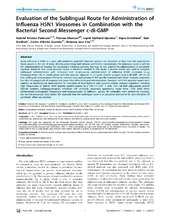| dc.contributor.author | Pedersen, Gabriel Kristian | en_US |
| dc.contributor.author | Ebensen, Thomas | en_US |
| dc.contributor.author | Gjeraker, Ingrid Hjetland | en_US |
| dc.contributor.author | Svindland, Signe | en_US |
| dc.contributor.author | Bredholt, Geir | en_US |
| dc.contributor.author | Guzmán, Carlos Alberto | en_US |
| dc.contributor.author | Cox, Rebecca Jane | en_US |
| dc.date.accessioned | 2012-02-21T10:55:14Z | |
| dc.date.available | 2012-02-21T10:55:14Z | |
| dc.date.issued | 2011-11-01 | eng |
| dc.Published | PLoS ONE 6(11): e26973 | en |
| dc.identifier.issn | 1932-6203 | |
| dc.identifier.uri | https://hdl.handle.net/1956/5628 | |
| dc.description.abstract | Avian influenza A H5N1 is a virus with pandemic potential. Mucosal vaccines are attractive as they have the potential to block viruses at the site of entry, thereby preventing both disease and further transmission. The intranasal route is safe for the administration of seasonal live-attenuated influenza vaccines, but may be less suitable for administration of pandemic vaccines. Research into novel mucosal routes is therefore needed. In this study, a murine model was used to compare sublingual administration with intranasal and intramuscular administration of influenza H5N1 virosomes (2 mg haemagglutinin; HA) in combination with the mucosal adjuvant (39,59)-cyclic dimeric guanylic acid (c-di-GMP). We found that sublingual immunisation effectively induced local and systemic H5N1-specific humoral and cellular immune responses but that the magnitude of response was lower than after intranasal administration. However, both the mucosal routes were superior to intramuscular immunisation for induction of local humoral and systemic cellular immune responses including high frequencies of splenic H5N1-specific multifunctional (IL-2+TNF-a+) CD4+ T cells. The c-di-GMP adjuvanted vaccine elicited systemic haemagglutination inhibition (HI) antibody responses (geometric mean titres $40) both when administered sublingually, intranasally and inramuscularly. In addition, salivary HI antibodies were elicited by mucosal, but not intramuscular vaccination. We conclude that the sublingual route is an attractive alternative for administration of pandemic influenza vaccines. | en_US |
| dc.language.iso | eng | eng |
| dc.publisher | Public Library of Science | eng |
| dc.rights | Attribution CC BY | eng |
| dc.rights.uri | http://creativecommons.org/licenses/by/2.5/ | eng |
| dc.title | Evaluation of the Sublingual Route for Administration of Influenza H5N1 Virosomes in Combination with the Bacterial Second Messenger c-di-GMP | en_US |
| dc.type | Peer reviewed | |
| dc.type | Journal article | |
| dc.description.version | publishedVersion | en_US |
| dc.rights.holder | Copyright 2011 Pedersen et al. | |
| dc.identifier.doi | https://doi.org/10.1371/journal.pone.0026973 | |
| dc.subject.nsi | VDP::Mathematics and natural science: 400::Basic biosciences: 470 | eng |
| dc.subject.nsi | VDP::Medical disciplines: 700::Basic medical, dental and veterinary science disciplines: 710::Medical microbiology: 715 | eng |

